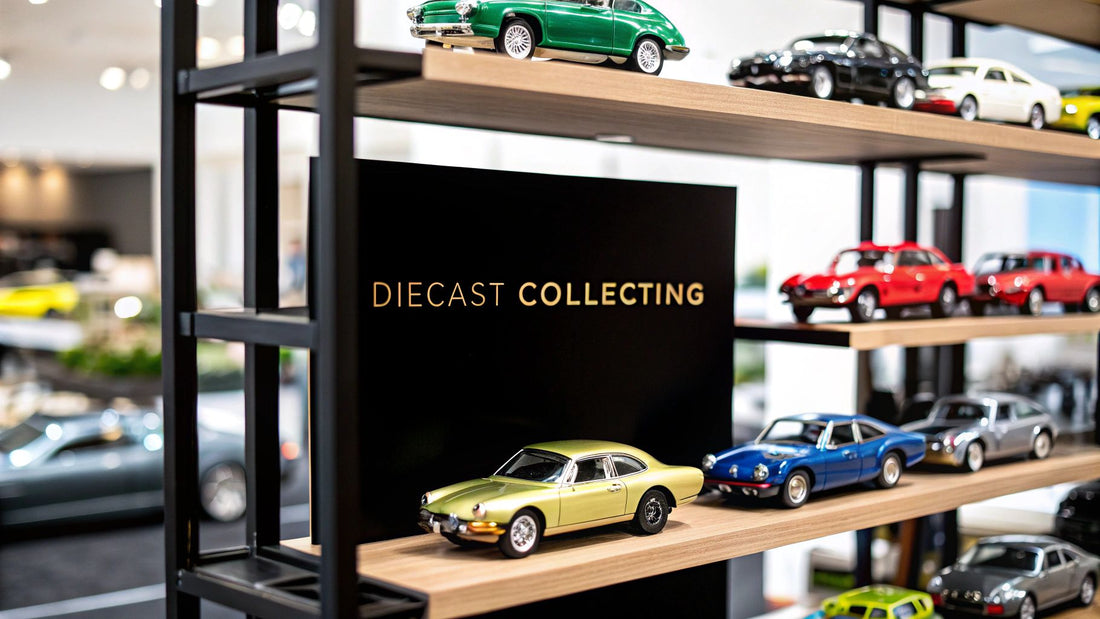
Your First Guide to Diecast Car Collecting
Diecast collecting is so much more than a hobby—it’s a hands-on connection to automotive history, incredible engineering, and your own personal memories. For millions of us, it’s about the feeling of holding a perfectly scaled piece of art, whether that's a classic Ford Mustang or a modern Formula One race car. This guide is your starting point for building a collection you'll love.
Why We Love Tiny Cars
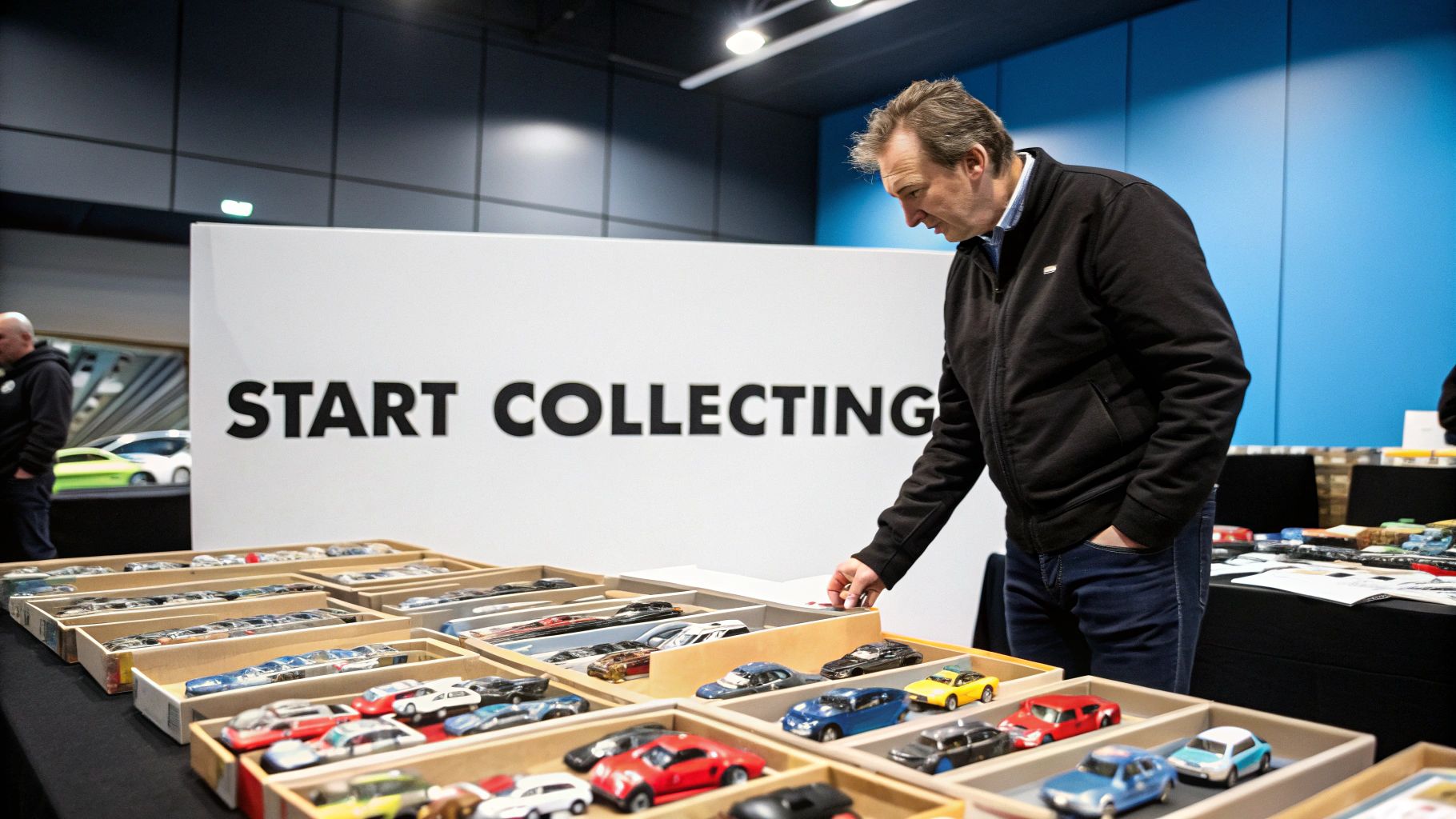
So, what makes someone want to fill a shelf with miniature cars? It’s a powerful mix of art, history, and the simple thrill of the hunt. Each model is like a tiny time capsule, capturing the design and spirit of its era in stunning detail.
For a lot of collectors, the spark is a memory—a first car, a dream car, or that awesome vehicle from a favorite movie. A detailed replica of a 1989 Batmobile isn’t just a model; it’s a direct link back to the excitement of being a kid. That nostalgic pull is a huge part of the hobby, turning metal and plastic into something genuinely special.
The Appreciation for Engineering
Beyond the memories, collecting diecast cars is a real appreciation for craftsmanship. It’s fascinating to see how manufacturers manage to replicate complex engines, detailed interiors, and authentic paint jobs on such a small scale. It's a celebration of precision engineering where every little decal and perfectly shaped wheel arch matters.
This isn’t just about gathering toys. It’s about curating your own gallery of automotive history. The reasons people collect are as diverse as the cars themselves:
- Nostalgia: Connecting with cars from your past or from pop culture.
- Design Appreciation: Admiring the beauty and engineering of iconic vehicles.
- The Thrill of the Hunt: That incredible feeling of finding a rare or limited-edition model.
- Community: Sharing your finds and passion with a global network of fellow collectors.
This shared passion fuels a huge global market. In fact, the diecast model car industry is on track to hit around $5 billion by 2025, proving just how much the hobby is growing across every generation.
At its heart, diecast collecting combines the meticulous nature of stamp collecting with the raw, emotional power of car culture. It lets you build your dream garage, one carefully chosen model at a time, without needing a billionaire’s budget.
The journey starts with a single car, but it quickly becomes a personal story told through metal and rubber. Digging into the quirky world of diecast collecting really shows how deep and rewarding this hobby can be, bringing together builders, dreamers, and storytellers.
Understanding Scales and Finding Your Fit
Jumping into diecast collecting without a grip on "scale" is a bit like trying to build a real car with a mismatched set of tools. It’s the single most important concept you’ll learn, because it defines a model’s size in relation to its real-world counterpart. Getting your head around this simple ratio is the first big step toward building a collection that looks and feels just right.
A scale like 1:18 simply means the model is one-eighteenth the size of the actual car. For every 18 inches of steel, glass, and rubber on the real thing, there's 1 inch of diecast metal on your model. This is the universal language collectors use, and it's what ensures a model you buy from halfway across the world is exactly the size you expect.
Let's put it another way. A 1:64 scale car is that classic, pocket-sized model you grew up with from brands like Hot Wheels or Matchbox. You can hold a handful of them. A 1:18 scale model, on the other hand, is a showstopper. It's a centerpiece for your desk or display case that demands its own space to be truly appreciated.
Decoding the Most Common Scales
Every scale offers a completely different collecting experience, creating a unique balance between detail, size, and cost. There’s no single "best" choice here—it all comes down to what fits your style, your space, and your budget. Knowing the key differences will help you start your journey on the right foot.
While there are many scales out there, three main players dominate the hobby, each with its own dedicated community.
- 1:64 Scale: This is the king of variety and sheer numbers. These models are typically 2.5 to 3 inches long, making them incredibly affordable and easy to find. They're perfect for beginners or anyone who gets a thrill from hunting for treasure in retail stores.
- 1:43 Scale: Often called the "collector's scale," especially in Europe. At about 4 to 5 inches long, these models hit a sweet spot, offering a fantastic balance between a manageable size and a major step-up in detail. You'll often find much more intricate paint and interior work compared to their 1:64 cousins.
- 1:18 Scale: The go-to choice for detail fanatics. These are big, impressive models, usually 9 to 12 inches long, and are prized for their stunning realism. It's common for them to feature opening doors, hoods, and trunks, complete with fully replicated engines and detailed cockpits.
For a deeper dive into the world of sizing, our guide on diecast model scales explained offers more comparisons to help you lock in your choice.
Choosing a scale is your first major decision as a collector. It will influence what you buy, how you display it, and even the community you connect with. Start with what excites you most, whether that's the sheer volume of 1:64 or the incredible realism of 1:18.
Common Diecast Car Scales Explained
To help you visualize the differences, we've put together a simple table that breaks down the most popular scales. Think of this as your quick-reference guide for understanding what each scale brings to the table in terms of size, detail, and its typical role in a collection.
| Scale | Approximate Length (Car) | Common Detail Level | Best For |
|---|---|---|---|
| 1:18 | 9-12 inches (23-30 cm) | Very High | Premium display, detail lovers, centerpiece models |
| 1:24 | 7-8 inches (18-20 cm) | High | Detailed displays, popular for American muscle cars |
| 1:43 | 4-5 inches (10-13 cm) | Good to High | Space-conscious collectors, European car collections |
| 1:64 | 2.5-3 inches (6-8 cm) | Basic to Good | Large volume collections, "treasure hunting," budget-friendly |
As you can see, the scale you pick directly impacts your collecting journey. From the desk-friendly 1:43 to the commanding presence of a 1:18, your choice sets the stage for everything that follows.
Matching Brands to Your Collecting Style
Just as scales differ, so do the manufacturers who make them. The brand you gravitate towards will often shape the level of detail, the types of cars available, and the price you can expect to pay. Learning the key players helps you zero in on the models that really speak to you.
The infographic below gives you a bird's-eye view of how collectors often categorize the major brands.
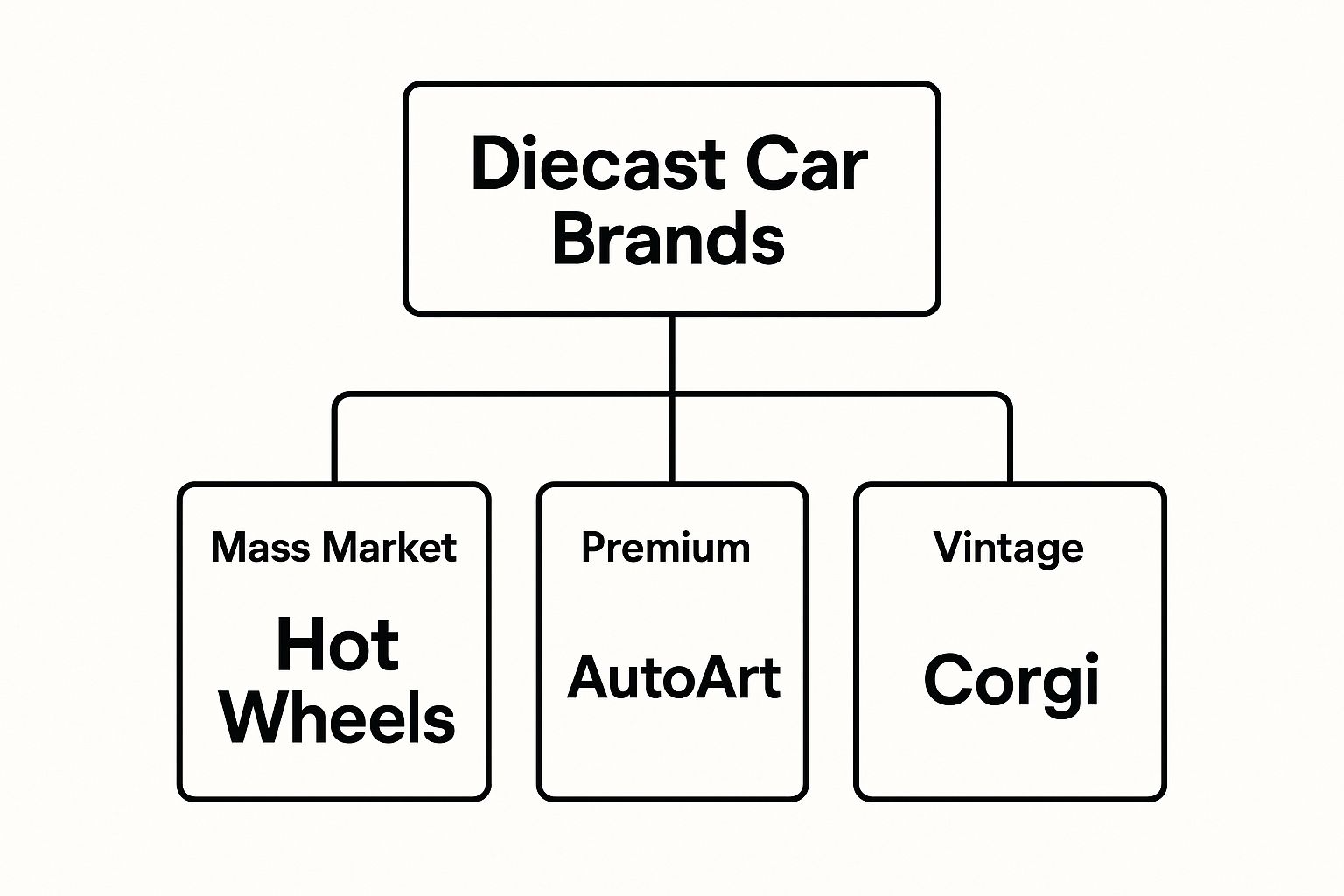
This kind of visual breakdown shows how brands cater to different tastes, from the fun, accessible models you can find anywhere to the high-end, premium replicas for the most serious enthusiasts. Ultimately, your brand preferences will give your collection its unique personality.
Whether you're hunting for the latest Hot Wheels "Treasure Hunt" at a local big-box store or saving up for a meticulously crafted model from AUTOart, your journey starts here. By picking a scale and a few favorite brands, you give yourself a clear direction, turning a world of endless options into a focused and exciting personal quest.
How to Start Your Collection The Smart Way
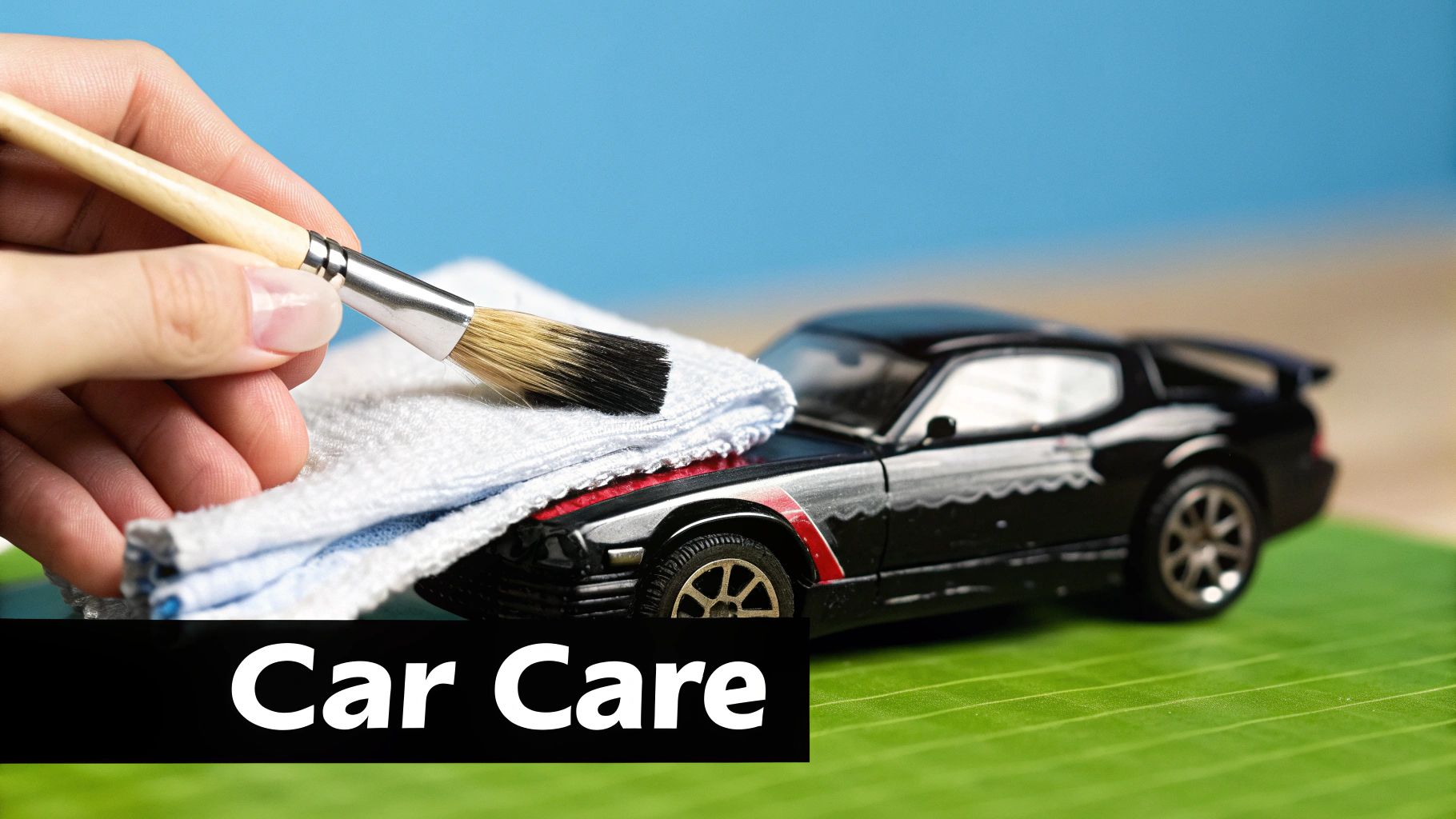
Now that you've got a handle on the different scales and brands, the real fun begins. That first step into diecast collecting is a huge thrill, but a little bit of planning can make all the difference. Without a clear path, it's incredibly easy to get swamped by the sheer number of choices and end up with a random pile of models instead of a collection you're genuinely proud of.
The secret to a rewarding journey is to start with a purpose. This is the moment you shift from just grabbing cool cars off the shelf to intentionally building a collection that tells a story—your story. And the best way to do that is to give it a theme.
Find Your Focus and Theme
Think of a theme as your collecting compass. It keeps you focused, makes the hunt way more exciting, and helps you build a collection that feels cohesive and looks incredible on a shelf. It’s like deciding to build a library of classic sci-fi novels instead of just buying whatever books you see. Both are great, but one has a clear identity.
Your theme can be absolutely anything that gets you excited. There are no rules here, just what you find cool. Some popular starting points are:
- Collecting by Marque: Go all-in on a single manufacturer you love, like Porsche, Ferrari, or Ford.
- Collecting by Era: Curate a garage from a specific decade—think the raw power of 60s muscle cars or the boxy icons of the 80s.
- Pop Culture Collections: Hunt down famous cars from movies and TV shows. We're talking the Batmobile, the DeLorean from Back to the Future, K.I.T.T., you name it.
- Motorsport Themes: Build a starting grid of Formula One champions, Le Mans legends, or iconic rally cars.
Once you have a theme, even a loose one, every trip to the store or scroll through an online shop becomes a mission. You're not just looking for cars; you're searching for the next piece of your puzzle.
Set Your Budget and Start Hunting
Diecast collecting is one of the most accessible hobbies out there, but it’s always smart to set a budget. You can build an amazing 1:64 scale collection for just a few dollars a week. On the other hand, a single, premium 1:18 model might be a special monthly or quarterly purchase. Figure out what you're comfortable spending so the hobby stays fun, not a financial headache.
With a theme and a budget, it’s time to find your first few models. For anyone just starting, the best places are often right around the corner.
Where to Make Your First Purchases:
- Big-Box Retailers (Walmart, Target): These stores are ground zero for hunting mainstream 1:64 scale brands like Hot Wheels and Matchbox. They get new stock all the time, making every visit a potential score.
- Local Hobby Shops: This is where you'll discover a wider variety of scales and premium brands. The owners are usually collectors themselves and can be an amazing source of advice.
- Online Diecast Stores: Websites dedicated to the hobby, like our own at Everything Diecast, offer a massive selection. You can find everything from pre-orders for upcoming releases to those hard-to-find models you've been chasing.
Your first few buys are about learning the ropes. Get what you love, see how the different brands feel in your hand, and just enjoy the process. A truly great collection is built over time, not overnight.
Discover the Thrill of the Treasure Hunt
As you start sifting through the pegs at retail stores, you'll quickly hear collectors whispering about "Treasure Hunts." This is where diecast collecting adds a shot of lottery-like adrenaline to a simple shopping trip. Brands like Hot Wheels intentionally mix limited-edition, more detailed models into their regular shipments.
Finding one is a rite of passage for many collectors. There are two main types to keep an eye out for:
- Treasure Hunts (TH): These are special versions of regular models. You can spot them by the small, circular flame logo printed somewhere on the car. The card behind the car will have that same logo.
- Super Treasure Hunts (STH): These are the true gems. They are much, much rarer and feature awesome upgrades like "Real Riders" (rubber tires) and premium "Spectraflame" paint. You can identify an STH by the little "TH" symbol (for "Treasure Hunt") hidden on the car's body.
The odds of finding a Super Treasure Hunt are pretty slim—some collectors estimate they appear in only one out of every 10 to 15 cases—which makes finding one in the wild an unforgettable moment. This "hunt" is what turns a casual hobby into a real adventure.
For a deeper look at getting started, check out our beginner's guide for diecast car collecting enthusiasts for more tips.
Finding and Valuing Your Next Find
As your collection grows from a few favorite models into a respectable lineup, your focus will naturally shift. The simple joy of finding a cool car evolves into a more strategic hunt for those elusive, hidden gems.
And with that comes the big question: what is this tiny car actually worth? This is where diecast collecting gets a little more interesting, blending the thrill of the marketplace with some fun detective work. Learning where to look beyond the big-box stores and how to assess a model like a pro is the next step in the journey.
Where to Hunt for Diecast Treasures
Once you’ve picked the pegs at your local Target clean, it’s time to expand your hunting grounds. The world of diecast collecting is huge, with passionate communities both online and in the real world. Each spot offers a different experience and, more importantly, a different opportunity to find something special.
Here are the best places to continue your search:
- Online Marketplaces: A site like eBay is basically the global hub for diecast. You can find almost anything here, from common mainlines to incredibly rare vintage pieces. The key is to always check a seller’s reputation and read the descriptions very carefully.
- Specialty Diecast Websites: Retailers like our own at Everything Diecast offer a more curated experience. We provide a hand-picked selection of new releases and sought-after models from top brands, so you know you're getting authentic, quality cars.
- Collector Forums and Social Media: Facebook Groups and dedicated forums are fantastic for connecting with other collectors. Many have "buy, sell, trade" sections where you can score great deals directly from fellow enthusiasts who know their stuff.
- Swap Meets and Conventions: These events are pure magic for a collector. Imagine walking into a room with thousands of models in one place. You can haggle on prices, trade for something you've been wanting, and just share stories with people who get your passion.
The real secret to finding great cars is persistence and an open mind. That forgotten box at a garage sale or the dusty shelf in an antique store might just hold the very model you've been searching for.
The Art of Diecast Valuation
So, why is one Hot Wheels car worth a single dollar while another, nearly identical one, can fetch over $100? The answer is a mix of factors that together determine a model’s desirability and its market value.
Getting a handle on these elements is what separates a casual buyer from a truly savvy collector. Think of yourself as an appraiser for miniature art. You're not just looking at a tiny car; you're assessing its history, condition, and rarity to understand its story. This knowledge helps you build a collection that has both personal meaning and potential financial value.
And it's not just a niche hobby; the car diecast scale model segment alone was valued at a whopping $1.32 billion in 2024. That number is projected to grow, showing a serious and expanding interest in authentic models. You can learn more about these market trends and their projections to see just how big this world is.
Key Factors That Determine a Model's Worth
To figure out what a diecast car is worth, you really only need to look at three main things. Nail these, and you'll be able to confidently size up any model you come across.
- Condition is King: A model in perfect, "mint" condition is the gold standard, period. For a car still in its original package, that means a crisp, unbent card and a clear, uncracked blister. For a loose car, it means zero paint chips, scratches, or broken parts. Even the smallest bit of wear can dramatically lower its value.
- Rarity Drives Demand: Rarity can come from a few different places. Some are intentional, like a limited production "Super Treasure Hunt" or a convention-exclusive model. But rarity can also be accidental—think of a factory error where a car was released with the wrong wheels or a color variation that was quickly pulled from production. These mistakes can be a collector's dream.
- Desirability Sets the Price: A car can be rare, but if nobody wants it, it won't be valuable. Desirability is all about what the community is currently chasing. Models of popular real-life cars (like a Porsche 911 or a classic Ford Mustang), famous movie vehicles, and cars with special features like rubber tires (known as "Real Riders") are almost always in high demand.
A fantastic resource for your research is hobbyDB, a massive online database for pretty much everything collectible. You can search for a specific model and see a price guide based on actual sales data, helping you value your collection like a true professional.
How to Protect and Display Your Collection
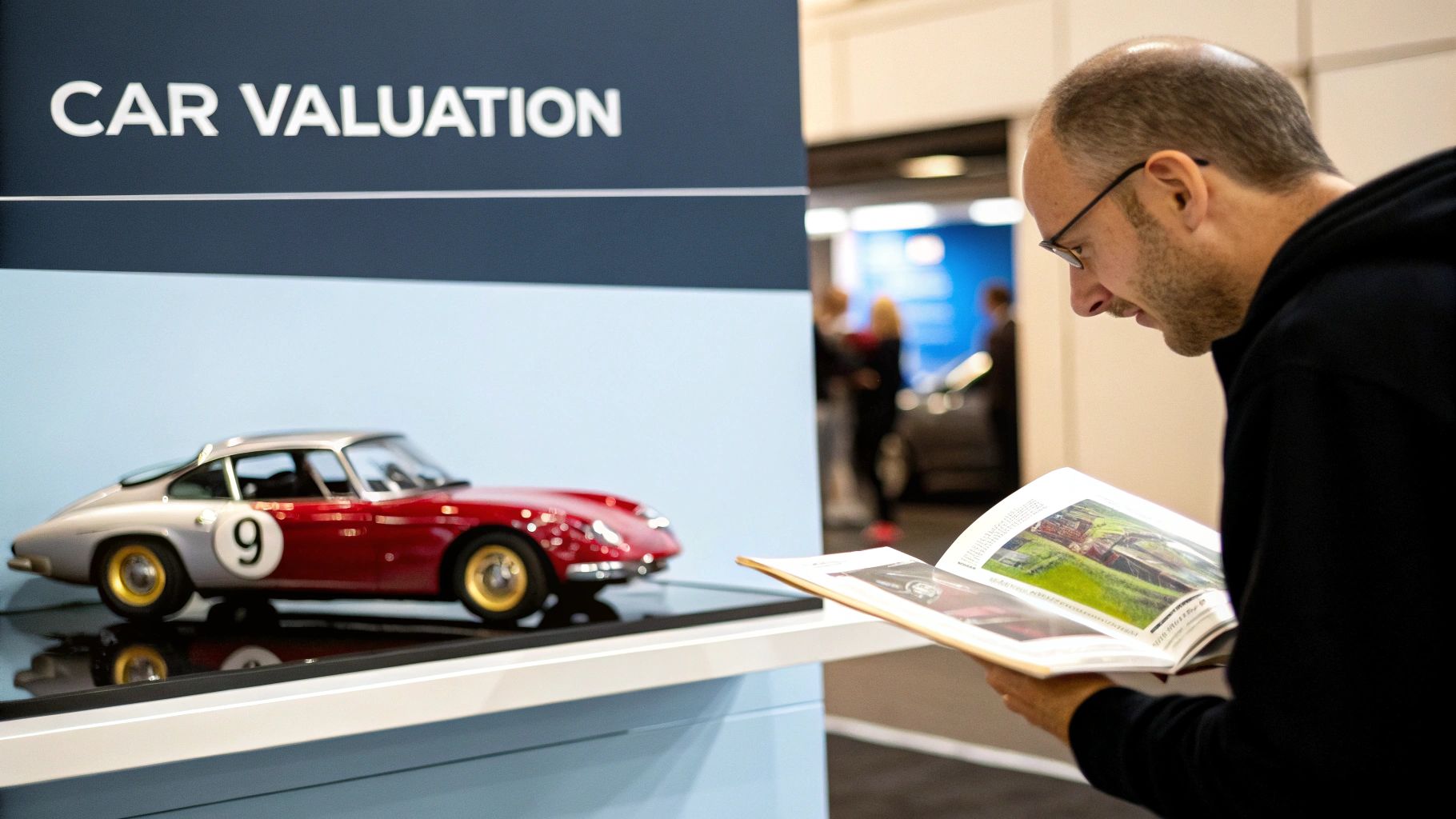
Your collection is so much more than just a bunch of model cars. It's a physical record of your passion, a testament to your dedication. Every single model represents hours of research and that irreplaceable thrill of a successful hunt. Protecting this investment isn't just about money—it's about preserving the art and craftsmanship you fell in love with in the first place.
Think of it this way: proper care and a smart display strategy ensure your models will look just as incredible years from now as they did the day you unboxed them. It’s how you transform a hobby into a personal gallery of automotive history you can be proud to show off.
Essential Care for Your Diecast Models
You can think of your diecast cars a lot like their full-sized counterparts—they need a bit of regular maintenance to stay in showroom condition. The biggest culprits you're fighting against are dust, sunlight, and humidity. Over time, these troublemakers can fade vibrant paint, warp delicate plastic parts, and even make decals peel right off.
The trick is to keep them clean without causing accidental damage. A heavy hand or the wrong cleaning supplies can easily snap off a tiny side mirror or scratch a perfect paint job. Gentle, consistent care is always the way to go.
For routine cleaning, here are a few pro-approved techniques:
- For Dusting: A soft-bristle makeup brush is fantastic for getting into all the nooks and crannies without applying pressure. A can of compressed air works wonders too, just be sure to use it from a safe distance.
- For Grime: If a model has picked up more than just dust, a slightly damp microfiber cloth with a single, tiny drop of mild soap will do the job. It's always a good idea to test it on an inconspicuous spot first, like the car's underside.
- Drying: Never let a model air dry, as this can leave behind ugly water spots. Gently pat it dry with a separate, completely clean microfiber cloth.
The single biggest threat to your collection's longevity is direct sunlight. UV rays are incredibly destructive, acting like a fast-forward button on aging. They will bleach paint colors, yellow clear plastic windows, and make rubber tires brittle over just a few months.
Choosing Your Display Strategy
How you choose to display your collection is just as important as how you clean it. A great display doesn't just protect your cars; it elevates them into a deliberate work of art. The right setup can turn what might look like a cluttered shelf into a curated museum exhibit.
Ultimately, your choice of display comes down to finding the right balance between three key things: protection, visibility, and your budget.
Affordable and Effective Display Ideas
You don't have to break the bank on a custom-built, museum-grade setup to make your collection look amazing. Plenty of collectors use creative and affordable solutions that provide excellent protection and look fantastic.
Some of the most popular options include:
- Wall-Mounted Cases: Brands like Carney Plastics make incredible cases, but even a repurposed shot glass cabinet can do the trick. This gets your collection up on the wall, turning it into an instant focal point while keeping dust far away.
- Individual Acrylic Cases: For your absolute favorite, most prized models, an individual clear acrylic case is a must. It gives you 360-degree visibility and total protection from dust and accidental bumps. They look sharp on a desk or a shelf.
- Bookcases with Glass Doors: Something as simple and widely available as an IKEA Billy bookcase with glass doors can be a collector's best friend. It can easily house hundreds of 1:64 scale cars, keeping them enclosed and safe while still letting you admire them.
No matter which path you take, just remember the goal: create a safe environment where you can enjoy your diecast collection without worrying about it. A well-protected model is one that will bring you joy for a lifetime.
Joining the Global Diecast Community
Your diecast collecting journey doesn't have to be a solo mission. The moment you get your hands on that first model, you've got an all-access pass to a massive, welcoming global community of people who share your passion. This is where the hobby truly comes alive, transforming from a simple personal interest into a shared adventure.
Connecting with fellow collectors is how you’ll learn about surprise releases, get tips on spotting rare finds, and see how others creatively display their prized possessions. It's how you stay inspired and deepen your appreciation for the art of tiny cars.
Finding Your People Online
These days, the internet is the central hub for the modern diecast community. From buzzing forums to visually stunning social media feeds, there are countless places to connect with people who get just as excited about a "Super Treasure Hunt" as you do.
Here are some of the best digital hangouts for collectors:
- Social Media Groups: Platforms like Facebook and Reddit are home to thousands of dedicated groups for diecast car collecting. You can find groups focused on specific brands like Hot Wheels or Matchbox, or broader communities for trading and just showing off your latest finds.
- Online Forums: Don't sleep on the classic forums—they are still a goldmine of deep knowledge. Hobby-specific websites have threads discussing everything from obscure model variations to the history of different brands.
- YouTube Channels: A huge number of creators produce fantastic content, from "peg hunting" vlogs and unboxing videos to incredibly detailed reviews of premium models. It's a great way to get an up-close look at new releases before you buy.
Following the Latest Trends
The world of diecast collecting is always on the move, with new trends and innovations keeping the hobby exciting. One of the biggest shifts has been the rise of new, hyper-detailed brands that are giving the established players a run for their money. Learning about these manufacturers can open up thrilling new avenues for your collection. Our comparative look at diecast manufacturers is a great place to start discovering who’s making what.
This global passion is fueling real market growth. It’s a hobby that’s expanding, especially in new regions, which means more variety and innovation for everyone.
The market is also seeing some incredible growth in specific areas. The Asia-Pacific region, for instance, has become a dynamic force, with a growing base of enthusiasts driving both production and sales. The global diecast model car market is projected to grow at a CAGR of 5.10% from 2023 to 2030, with this region playing a huge part in that expansion. You can explore more insights on the diecast market's growth here.
This kind of growth is great news for us collectors. It ensures a steady stream of new models and a vibrant future for the hobby. When you join the community, you're not just collecting cars—you're plugging into a thriving global movement.
Common Questions from New Collectors
Jumping into the world of diecast collecting is exciting, but it naturally comes with a few questions. It’s a common feeling—we’ve all been there, wondering where to even start.
Let's clear up some of the most common uncertainties that beginners face. Think of this as your roadmap for that first thrilling hunt, helping you start your collection with confidence.
What's the Best Scale to Start With?
Choosing your first scale really sets the stage for your entire collection. It's one of the most important decisions you'll make early on.
Most collectors get their start with 1:64 scale models. Why? They're affordable, easy to find, and don't take up much space. These little pocket-sized cars let you build a diverse and exciting collection without a huge investment or needing a ton of shelf space.
- 1:64 Scale: The classic starting point. It's budget-friendly and perfect for building a large collection.
- 1:43 Scale: A great middle-ground, offering a nice balance between detail and size.
- 1:24 Scale: Now you're getting into more noticeable realism with a larger, more substantial model.
- 1:18 Scale: The king of detail. These are true centerpiece models meant for prominent display.
Ultimately, your choice will come down to how much space you have and what you want your display to look like.
Should I Keep the Packaging or Open My Models?
Ah, the classic collector's dilemma: to open or not to open? There’s no single right answer, but here’s how most people approach it.
A model kept in its original, unopened packaging will almost always hold a higher resale value. The box or blister card does more than just look good; it protects the car from dust, scratches, and the dreaded sun-fading that can ruin a model's paint over time.
However, a huge part of the fun is getting to hold the car and appreciate all those tiny details up close—the interior, the engine, the feel of it in your hand. Many collectors solve this by buying two of a model they really love: one to keep sealed and one to display loose.
Original packaging preserves a model's condition and can add up to 25% or more to its value on the secondary market.
Remember, this is your collection. Sometimes, the simple joy of appreciating a model outweighs any potential resale value.
How Do I Spot a Rare or Valuable Car?
Learning to spot the gems is part of the thrill of the hunt. Rarity usually comes down to a few key things: limited production runs, special editions, and those quirky little factory errors.
Keep an eye out for models from series like Hot Wheels' "Super Treasure Hunt" (STH) or exclusives sold only at specific conventions. These are intentionally produced in small numbers and are highly sought after from day one.
"Error cars can be the most surprising finds."
Sometimes a car leaves the factory with the wrong wheels, a missing logo, or an upside-down base. These mistakes create instant rarities. To get a feel for what something is actually worth, check the "sold" listings on eBay or a collector database like hobbyDB. This shows you what people are actually paying for a car right now, which is the best measure of its market value.
Where Are the Best Places to Find Diecast Models?
The hunt is half the fun, and great finds can be hiding in all sorts of places. Your journey will probably start at big-box retailers like Walmart and Target, which are fantastic for finding the latest mainstream releases from brands like Hot Wheels and Matchbox.
For more premium brands and expert advice, your local hobby shop is an invaluable resource. Then there's the online world. Platforms like eBay and specialty diecast websites open up a global marketplace right from your couch.
Don't forget about in-person events! Collector conventions and swap meets are goldmines for rare finds and exclusive releases you won't see in stores. You can also connect with fellow collectors through forums and social media groups to trade directly. A good strategy mixes both online and in-person hunting to give you the best shot at finding great deals and hidden treasures.
As you get more familiar with these fundamentals, collecting will feel like second nature. Enjoy the process and every discovery along the way.
Quick Pro Tips
- Catalog Your Collection: Start a simple spreadsheet or use a dedicated app. Track what you have with photos and notes on its condition. You'll thank yourself later.
- Display with Care: Use soft LED lighting for your display cases. It shows off your cars beautifully without the harmful UV rays that can fade paint over time.
- Join the Community: Find a local diecast club or online forum. It's the best way to learn, find swap meets, and arrange for exclusive trades.
Ready to explore our full selection of detailed diecast models? Check out Everything Diecast at https://everythingdiecast.net
Article created using Outrank